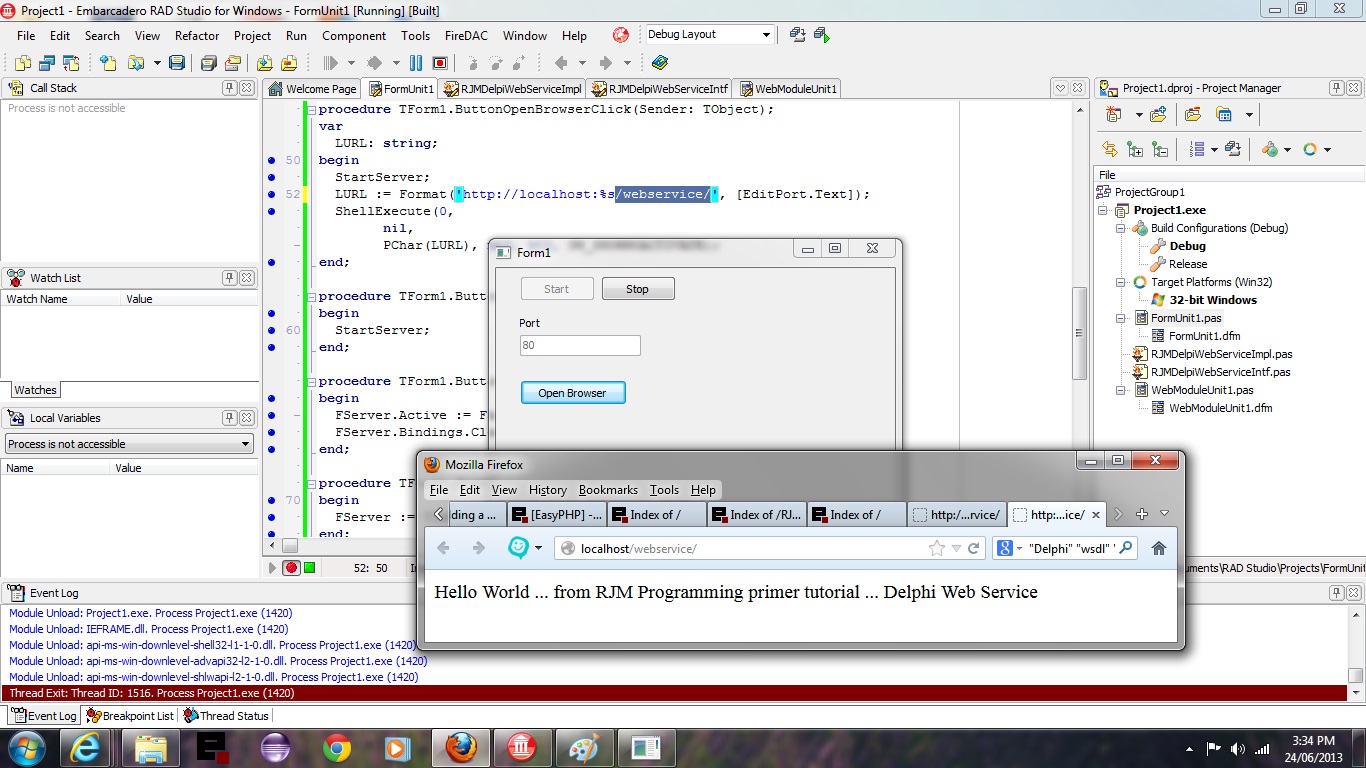Have you heard of Delphi? Maybe you know it as Turbo Delphi? It is a great GUI IDE application that can create desktop or web applications. It has inbuilt functionality to create a Web Service, and this primer tutorial shows you the easier parts of this, but leaves a lot of further research for the reader! Hope you are up to it?!
Embarcadero Delphi is an integrated development environment (IDE) for console, desktop graphical, web, and mobile applications.[1]
Delphi’s compilers use their own Object Pascal dialect of Pascal and generate native code for 32- and 64-bit Windows operating systems, as well as 32-bit Mac OS X and iOS. (iOS code generation is done with the Free Pascal compiler.[2]) As of late 2011 support for the Linux and Android operating system was planned by Embarcadero.[3]
To create applications for managed code platforms, a similar (but not mutually compatible) alternative is Delphi Prism.
Delphi was originally developed by Borland as a rapid application development tool for Windows, and as the successor of Borland Pascal. Delphi and its C++ counterpart, C++Builder, shared many core components, notably the IDE and VCL, but remained separate until the release of RAD Studio 2007. RAD Studio is a shared host for Delphi, C++Builder, and others.
In 2006, Borland’s developer tools section were transferred to a wholly owned subsidiary known as CodeGear, which was sold to Embarcadero Technologies in 2008.
Turbo Delphi was an Integrated Development Environment (IDE), created by CodeGear, which was targeted towards student, amateur, individual professionals, and hobbyist programmers. It used the Delphi programming language, which is a dialect of Pascal.
Turbo Delphi was announced on 8 August 2006. It became available for download on 5 September 2006.
There were two versions of Turbo Delphi, one which generates native Win32 applications (Turbo Delphi for Windows), and one that generated bytecode for the Microsoft .NET CLR. Each version came in two editions, a free Explorer edition and a Professional edition. The Professional edition was a commercial product available for purchase from Borland/Embarcadero, and it allowed extension and customization of the IDE which was not available in the Explorer edition.
It was most recently distributed by the CodeGear division of Embarcadero Technologies, which was purchased from Borland in 2008. [1] In October 2009, Embarcadero discontinued support of Turbo Delphi, along with the other Turbo products including Turbo C++. The product is not available for download any longer,[2] and it is not possible to receive a registration key from Embarcadero which was required to use the product. The latest release of Turbo Delphi was 2006, and it was based upon Embarcadero’s product Delphi 2006.
My experience with Delphi is to have “cloned” one Delphi Application with a database component to another very similar scenario. This is a limited range of experience but found the use of (Turbo) Delphi (Pascal) to be different to Visual Studio, but reasonably user friendly and perhaps better in some ways. Could probably say the same about XCode. All IDEs have their strengths and weaknesses, just as Pascal has its strengths and weaknesses compared to other languages, so you would expect that, and know that there are some fairly passionate fans of Delphi out there.
In this primer tutorial on Windows you can see an Embarcadero Delphi Pascal Web Service Application in action. It incorporates a local EasyPHP (or WAMP) Web Server as its agent, and you can read about EasyPHP at EasyPHP Windows Framework for PHP/MySql Tutorial. EasyPHP uses port 80, and this was a change made from the Delphi Pascal default port of 8080 (which is the Apache Tomcat Web Server default port) presented to you as the default port when you use Delphi Pascal to create your Web Service application (yourself). The way EasyPHP uses port 80 means that http://localhost/ works (because 80 is your default http port), even though what you mean is http://localhost:80/ (wake up!!) The general idea of this tutorial is that a Web Service is created from scratch, but the last couple of slides of the tutorial make you aware of the possibility that you can import an existing wsdl file for further functionality. For more information about wsdl files, and Web Services generally, I want to direct you to Java Eclipse Web Service Primer Tutorial and to the Delphi Web Service information link below.
Link to Embarcadero Delphi more information … via Wikipedia, where quote above came from..
Link to Turbo Delphi more information … via Wikipedia, where quote above came from..
Link to Delphi Web Service information at Embarcadero which formed the basis for this tutorial.
Link to Delphi download website at Embarcadero.
If this was interesting you may be interested in this too.




27 Responses to Delphi Pascal Windows Service Primer Tutorial